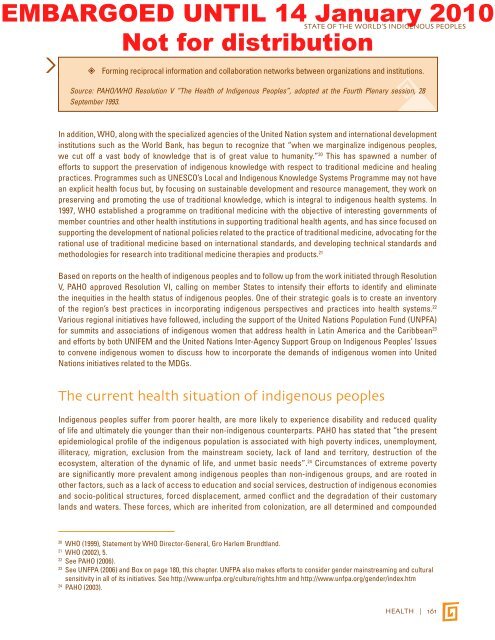STATE OF THE WORLD's INDIGENOUs PEOpLEs - CINU
STATE OF THE WORLD's INDIGENOUs PEOpLEs - CINU
STATE OF THE WORLD's INDIGENOUs PEOpLEs - CINU
- No tags were found...
Create successful ePaper yourself
Turn your PDF publications into a flip-book with our unique Google optimized e-Paper software.
EMBARGOED UNTIL 14 January 2010<strong>STATE</strong> <strong>OF</strong> <strong>THE</strong> WORLD’S INDIGENOUS PEOPLESNot for distributionForming reciprocal information and collaboration networks between organizations and institutions.Source: PAHO/WHO Resolution V “The Health of Indigenous Peoples”, adopted at the Fourth Plenary session, 28September 1993.In addition, WHO, along with the specialized agencies of the United Nation system and international developmentinstitutions such as the World Bank, has begun to recognize that “when we marginalize indigenous peoples,we cut off a vast body of knowledge that is of great value to humanity.” 20 This has spawned a number ofefforts to support the preservation of indigenous knowledge with respect to traditional medicine and healingpractices. Programmes such as UNESCO’s Local and Indigenous Knowledge Systems Programme may not havean explicit health focus but, by focusing on sustainable development and resource management, they work onpreserving and promoting the use of traditional knowledge, which is integral to indigenous health systems. In1997, WHO established a programme on traditional medicine with the objective of interesting governments ofmember countries and other health institutions in supporting traditional health agents, and has since focused onsupporting the development of national policies related to the practice of traditional medicine, advocating for therational use of traditional medicine based on international standards, and developing technical standards andmethodologies for research into traditional medicine therapies and products. 21Based on reports on the health of indigenous peoples and to follow up from the work initiated through ResolutionV, PAHO approved Resolution VI, calling on member States to intensify their efforts to identify and eliminatethe inequities in the health status of indigenous peoples. One of their strategic goals is to create an inventoryof the region’s best practices in incorporating indigenous perspectives and practices into health systems. 22Various regional initiatives have followed, including the support of the United Nations Population Fund (UNPFA)for summits and associations of indigenous women that address health in Latin America and the Caribbean 23and efforts by both UNIFEM and the United Nations Inter-Agency Support Group on Indigenous Peoples’ Issuesto convene indigenous women to discuss how to incorporate the demands of indigenous women into UnitedNations initiatives related to the MDGs.The current health situation of indigenous peoplesIndigenous peoples suffer from poorer health, are more likely to experience disability and reduced qualityof life and ultimately die younger than their non-indigenous counterparts. PAHO has stated that “the presentepidemiological profile of the indigenous population is associated with high poverty indices, unemployment,illiteracy, migration, exclusion from the mainstream society, lack of land and territory, destruction of theecosystem, alteration of the dynamic of life, and unmet basic needs”. 24 Circumstances of extreme povertyare significantly more prevalent among indigenous peoples than non-indigenous groups, and are rooted inother factors, such as a lack of access to education and social services, destruction of indigenous economiesand socio-political structures, forced displacement, armed conflict and the degradation of their customarylands and waters. These forces, which are inherited from colonization, are all determined and compounded20WHO (1999), Statement by WHO Director-General, Gro Harlem Brundtland.21WHO (2002), 5.22See PAHO (2006).23See UNFPA (2006) and Box on page 180, this chapter. UNFPA also makes efforts to consider gender mainstreaming and culturalsensitivity in all of its initiatives. See http://www.unfpa.org/culture/rights.htm and http://www.unfpa.org/gender/index.htm24PAHO (2003).HEALTH | 161
















